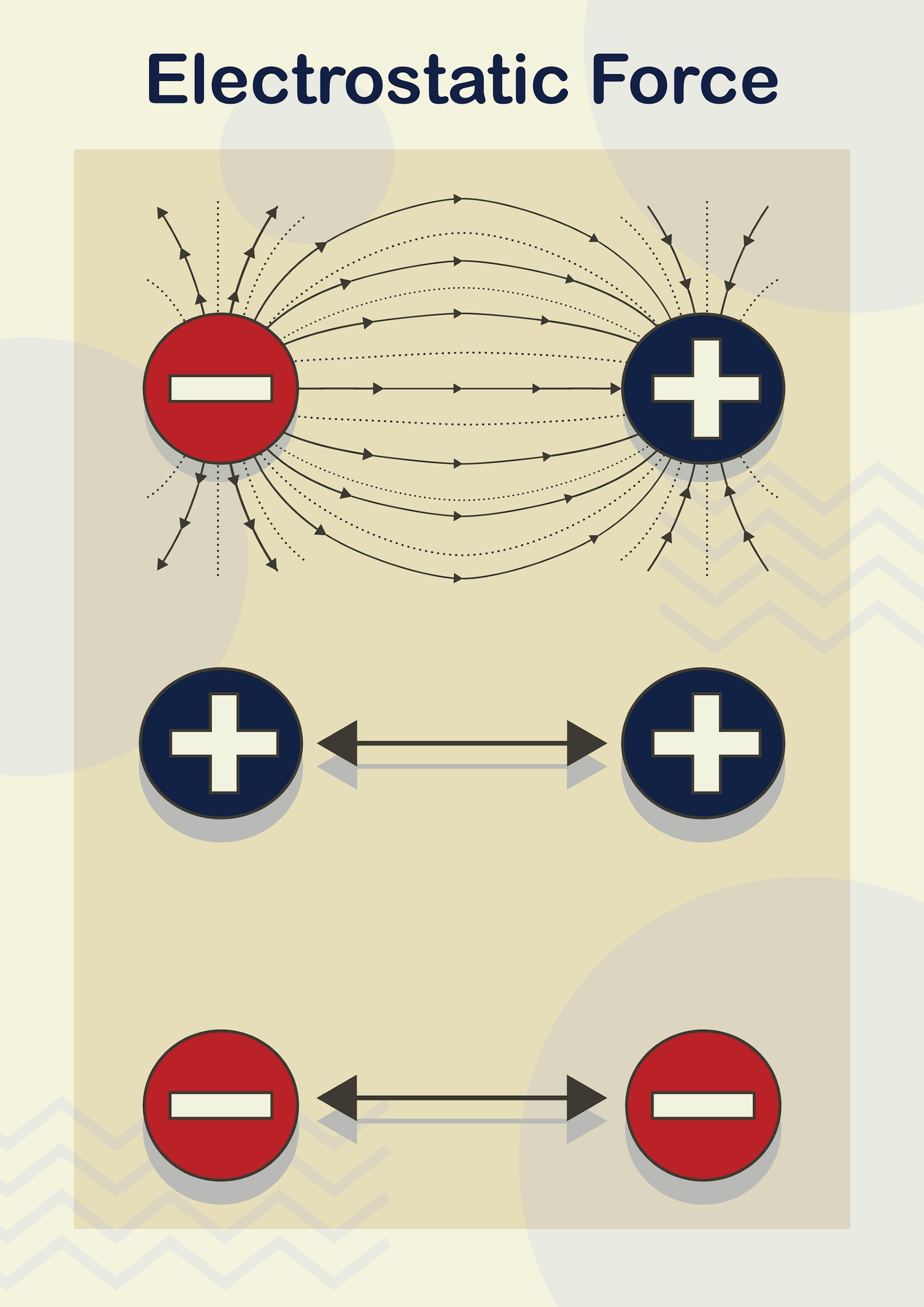Why Do I Keep Getting Shocked? This is a common question, and WHY.EDU.VN is here to help you understand the science behind static electricity and how to minimize those annoying zaps. We’ll explore the underlying physics of static, examine the factors that contribute to its build-up, and provide practical tips to reduce electrostatic discharge. Discover solutions to electrostatic shocks and learn about grounding techniques.
1. What is Static Electricity and How Does it Work?
To truly answer “Why do I keep getting shocked,” we must first understand what static electricity is and how it originates. Static electricity is an imbalance of electric charges within or on the surface of a material. This imbalance occurs because charges accumulate and cannot easily move away. To understand the science, let’s dive into the atomic level.
1.1 The Atomic Structure
Everything around us is made up of atoms. At the center of each atom is a nucleus, containing positively charged protons and neutral neutrons. Orbiting this nucleus are negatively charged electrons. Under normal circumstances, an atom has an equal number of protons and electrons, making it electrically neutral.
1.2 Imbalance of Charges
Static electricity arises when there is an imbalance of these charges. This often happens due to the phenomenon known as the triboelectric effect. When two different materials are rubbed together, electrons can transfer from one material to the other. The material that gains electrons becomes negatively charged, while the material that loses electrons becomes positively charged.
1.3 Electrostatic Discharge
Once a material has accumulated a static charge, it remains charged until there is a way for the charges to neutralize. This neutralization often occurs through electrostatic discharge (ESD), commonly experienced as a static shock. When a charged object comes close to another object with a different electrical potential (especially a conductor), the excess electrons jump across the gap, creating a small current. This sudden flow of electrons is what you feel as a shock.
2. Factors Contributing to Static Electricity Buildup
Several factors can increase your likelihood of experiencing static shocks. Understanding these factors can help you take steps to reduce them.
2.1 Material Properties
Some materials are more prone to static buildup than others. This is due to their position on the triboelectric series, which ranks materials based on their tendency to gain or lose electrons.
| Material | Tendency |
|---|---|
| Rabbit Fur | Highly Positive |
| Glass | Positive |
| Human Hair | Positive |
| Nylon | Positive |
| Wool | Positive |
| Fur | Positive |
| Lead | Slightly Positive |
| Silk | Slightly Positive |
| Aluminum | Neutral |
| Paper | Neutral |
| Cotton | Neutral |
| Steel | Neutral |
| Wood | Neutral |
| Amber | Negative |
| Hard Rubber | Negative |
| Nickel, Copper | Negative |
| Brass, Silver | Negative |
| Gold, Platinum | Negative |
| Polyester | Negative |
| Orlon | Negative |
| Saran | Highly Negative |
| Polyurethane | Highly Negative |
| Polypropylene | Highly Negative |
| PVC (Vinyl) | Highly Negative |
| Silicon | Highly Negative |
| Teflon | Extremely Negative |



2.2 Humidity Levels
Humidity plays a significant role in static electricity. Dry air is a better insulator, meaning it prevents the movement of electrons.
During dry conditions, charges accumulate more readily. Conversely, humid air contains more moisture, which helps dissipate static charges, reducing the likelihood of shocks.
2.3 Friction
Friction between materials is a primary cause of static charge buildup. When two surfaces rub against each other, electrons can be transferred.
For example, walking across a carpet in socks causes friction, leading to a buildup of static charge on your body.
2.4 Clothing Choices
The type of clothing you wear can significantly affect static electricity. Synthetic fabrics like polyester and nylon are more likely to generate static compared to natural fibers like cotton.
2.5 Footwear
Your choice of footwear also matters. Rubber soles are insulators and can contribute to static buildup, while leather soles are more conductive and less likely to cause static.
3. Why Some People Experience More Static Shocks
Not everyone experiences static shocks to the same degree. Several factors contribute to individual differences.
3.1 Skin Type
Dry skin is more prone to static buildup because it lacks moisture to dissipate charges. Individuals with naturally dry skin may experience more shocks.
3.2 Sensitivity
Some people are simply more sensitive to electrical discharges. Even a small static shock can feel more intense to them.
3.3 Body Size
A larger body may accumulate more charge than a smaller one, potentially leading to more noticeable shocks when discharged.
3.4 Health Conditions
Certain medical conditions or medications can affect skin moisture and sensitivity, which can influence the frequency of static shocks.
4. Common Scenarios Where Static Shocks Occur
Static shocks are more likely to occur in certain environments and situations. Recognizing these scenarios can help you anticipate and avoid them.
4.1 Touching Door Handles
Metal door handles are common culprits for static shocks because they are conductive and provide an easy path for electrons to discharge.
4.2 Walking on Carpets
Walking on carpets, especially in dry conditions, generates friction that leads to static buildup.
4.3 Handling Electronics
Touching electronic devices can result in static shocks, which can potentially damage sensitive components.
4.4 Petting Furry Animals
Petting animals with fur can cause static buildup due to friction between your hand and the animal’s fur.
4.5 Getting out of a Car
Sliding across car seats, especially those made of synthetic materials, can generate static electricity.
5. Practical Tips to Reduce Static Shocks
Fortunately, there are several practical steps you can take to minimize static shocks.
5.1 Use a Humidifier
Increasing the humidity in your home or office helps dissipate static charges. Aim for a humidity level between 40% and 60%.
5.2 Moisturize Your Skin
Keeping your skin moisturized reduces friction and static buildup. Use lotions and creams regularly, especially during dry seasons.
5.3 Choose Natural Fabrics
Opt for clothing made from natural fibers like cotton, wool, or silk, which are less prone to static buildup compared to synthetic fabrics.
5.4 Fabric Softeners and Dryer Sheets
Use fabric softeners in the laundry and dryer sheets in the dryer to reduce static cling and charge buildup on clothing.
5.5 Anti-Static Sprays
Apply anti-static sprays to carpets, upholstery, and clothing to minimize static buildup.
5.6 Wear Leather-Soled Shoes
Choose shoes with leather soles, as they are more conductive and less likely to cause static buildup compared to rubber soles.
5.7 Touch Metal Objects with a Key or Coin
Before touching metal objects, use a key or coin to discharge any static electricity. This provides a less intense shock than touching the object directly.
5.8 Increase Hydration
Drinking plenty of water helps keep your skin hydrated from the inside out, reducing dryness and static buildup.
6. Advanced Techniques for Static Control
For environments where static control is critical, such as electronics manufacturing or laboratories, more advanced techniques are necessary.
6.1 Anti-Static Wrist Straps
These straps are used to ground individuals, preventing static buildup while working with sensitive electronic components.
6.2 Conductive Flooring
Conductive flooring materials help dissipate static charges, preventing buildup in the work environment.
6.3 Ionizing Air Blowers
Ionizing air blowers neutralize static charges by introducing ions into the air, which attract and neutralize charged particles.
6.4 Static Dissipative Mats
These mats are placed on work surfaces to provide a safe, static-free area for handling electronic components.
7. Static Electricity and Electronics
Static electricity can be particularly problematic when it comes to electronic devices. Even a small static discharge can damage sensitive components.
7.1 Potential Damage
Static shocks can cause latent damage to electronic components, which may not be immediately apparent but can lead to premature failure.
7.2 Safe Handling Practices
When handling electronics, always ground yourself using an anti-static wrist strap and work on a static dissipative surface.
7.3 Storage Precautions
Store electronic components in anti-static bags to protect them from static discharge.
8. Static Electricity in Industry
Static electricity poses significant risks in various industries, including manufacturing, healthcare, and oil and gas.
8.1 Manufacturing
In manufacturing, static discharge can damage electronic components, disrupt production processes, and pose a fire hazard in environments with flammable materials.
8.2 Healthcare
In healthcare, static can interfere with medical equipment and pose a risk to patients with implanted electronic devices.
8.3 Oil and Gas
In the oil and gas industry, static discharge can ignite flammable vapors, leading to explosions and fires.
9. Debunking Myths About Static Electricity
There are several misconceptions about static electricity. Let’s debunk some common myths.
9.1 Myth: Static Shocks are Always Harmful
While static shocks can be annoying, they are generally harmless. However, they can be dangerous in specific environments, such as those with flammable materials.
9.2 Myth: You Can Eliminate Static Electricity Completely
It is impossible to eliminate static electricity entirely, but you can take steps to minimize its buildup and effects.
9.3 Myth: Only Synthetic Fabrics Cause Static
While synthetic fabrics are more prone to static, natural fabrics can also cause static buildup under certain conditions.
10. The Science of Lightning: A Large-Scale Static Discharge
Lightning is a dramatic example of static electricity on a massive scale. It occurs when electrical charges build up in storm clouds due to the friction between ice crystals and water droplets.
10.1 Charge Separation in Clouds
As these particles collide, they transfer electrons, leading to a separation of charges within the cloud. Typically, the bottom of the cloud becomes negatively charged, while the top becomes positively charged.
10.2 Lightning Discharge
When the electrical potential between the cloud and the ground becomes high enough, a rapid discharge occurs, creating a lightning strike. This discharge can heat the air to temperatures five times hotter than the surface of the sun.
10.3 Safety During Lightning Storms
During a lightning storm, it is crucial to seek shelter indoors and avoid contact with metal objects or bodies of water.
11. Innovations in Static Electricity Research
Researchers are continually exploring new ways to understand and control static electricity.
11.1 Nanomaterials
Nanomaterials are being developed to create anti-static coatings and fabrics with enhanced properties.
11.2 Energy Harvesting
Researchers are exploring methods to harvest static electricity and convert it into usable energy.
11.3 Advanced Sensors
Advanced sensors are being developed to detect and monitor static charge buildup in industrial environments, enabling proactive control measures.
12. Case Studies: Real-World Static Electricity Problems
Examining real-world cases can provide valuable insights into the challenges posed by static electricity and the solutions employed to address them.
12.1 Electronics Manufacturing Plant
An electronics manufacturing plant experienced frequent disruptions due to static discharge damaging sensitive components. Implementing anti-static wrist straps, conductive flooring, and ionizing air blowers significantly reduced these disruptions.
12.2 Hospital Operating Room
A hospital operating room faced issues with static interfering with medical equipment. Using conductive mats and anti-static sprays helped maintain a safe and reliable environment.
12.3 Chemical Processing Plant
A chemical processing plant had concerns about static igniting flammable vapors. Grounding equipment and using anti-static clothing mitigated the risk of explosions and fires.
13. The Future of Static Control
The field of static control is continually evolving, with new technologies and techniques emerging to address the challenges posed by static electricity.
13.1 Smart Textiles
Smart textiles with integrated anti-static properties are being developed for various applications, including clothing and industrial uses.
13.2 Self-Charging Devices
Researchers are exploring ways to create self-charging devices that harvest static electricity from the environment.
13.3 Predictive Modeling
Predictive modeling techniques are being used to forecast static charge buildup in industrial environments, enabling proactive control measures.
14. FAQ: Common Questions About Static Electricity
Here are some frequently asked questions about static electricity.
- What causes static electricity?
Static electricity is caused by an imbalance of electric charges on a material’s surface, usually due to friction. - Is static electricity dangerous?
Generally, static electricity is harmless, but it can damage sensitive electronics and pose a fire hazard in certain environments. - Why do I get shocked more in the winter?
Dry winter air allows static charges to build up more easily because there is less moisture to dissipate the charges. - How can I prevent static shocks when touching door handles?
Touch metal objects with a key or coin to discharge static electricity before touching the object directly. - Do certain fabrics cause more static electricity?
Yes, synthetic fabrics like polyester and nylon are more prone to static buildup than natural fibers like cotton. - Can static electricity damage my computer?
Yes, static discharge can damage sensitive electronic components in your computer. - How can I reduce static in my home?
Use a humidifier, moisturize your skin, and choose natural fabrics for clothing and upholstery. - What are anti-static wrist straps used for?
Anti-static wrist straps ground individuals, preventing static buildup while working with sensitive electronic components. - Does walking on carpet cause static electricity?
Yes, walking on carpet, especially in dry conditions, generates friction that leads to static buildup. - Why do I sometimes see a spark when I get shocked?
The spark is the visible discharge of electrons jumping from a negatively charged object to a positively charged one, creating a small current.
15. Conclusion: Mastering Static Electricity
Understanding why you keep getting shocked involves grasping the fundamental principles of static electricity, recognizing the factors that contribute to its buildup, and implementing practical strategies to minimize its effects. By taking proactive measures, you can reduce the frequency and intensity of static shocks and protect sensitive electronics from damage.
Are you still curious about static electricity or have more specific questions? Don’t hesitate to visit WHY.EDU.VN. Our platform provides expert answers and in-depth explanations to all your queries. Whether you’re seeking advanced techniques for static control or simply want to understand the science behind those everyday zaps, WHY.EDU.VN is your go-to resource. Explore a world of knowledge and discover why millions trust us for reliable answers. For personalized assistance, reach out to us at 101 Curiosity Lane, Answer Town, CA 90210, United States or via Whatsapp at +1 (213) 555-0101. Let why.edu.vn be your guide to understanding the world around you.
